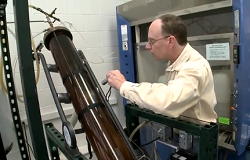Led in part by the National Wildlife Federation (NWF), the Roundtable on Sustainable Biofuels (RSB) has launched the first global third-party certification system for sustainable biofuels. To be certified “sustainable” the fuel must meet a set of environmental, social and economic principles and criteria set forth by the group. The certification process takes place online and there are online tools available to assist in the process.
“It’s one thing to say your product is sustainable and another to prove it,” said Barbara Bramble, Senior Advisor for the International Climate and Energy Program at the National Wildlife Federation. “This new system makes it easy to differentiate between biofuels that are environmentally destructive and biofuels that deliver on the promise of sustainability.”
 Many groups and organizations have lobbied global concerns over the development of biofuels including indirect land use, food versus fuel, biogenic emissions and land grabbing. The certification system covers all of these major issues and more including their contribution to climate change mitigation and rural development; their protection of land and labor rights; and their impacts on biodiversity, soil and water pollution, water availability and food security.
Many groups and organizations have lobbied global concerns over the development of biofuels including indirect land use, food versus fuel, biogenic emissions and land grabbing. The certification system covers all of these major issues and more including their contribution to climate change mitigation and rural development; their protection of land and labor rights; and their impacts on biodiversity, soil and water pollution, water availability and food security.
“All biofuels are not created equal,” said Bramble. “Bringing accountability, consistency and transparency to the global biofuels market is a giant first step toward stopping those practices that result in tropical deforestation, habitat destruction and increased pollution. The RSB is all about enabling biofuels markets to reward those producers who protect natural resources and avoid negative impacts on local communities.”
The certification system will be operated by RSB Services, which is the “business arm” of the RSB, providing access to the certification process, licensing, and auditors’ training among other activities. During the meetings to approve the certification, more than 120 organizations that included farmers, refiners, retailers, and NGOs came to an agreement. Now the group is asking the marketplace to recognize the industry leaders who are producing sustainable biofuels.


 Biotech firm
Biotech firm 


 PGI, a technology development company, has been testing their propriatary Corn Oil and Protein Extraction (COPE) process at GTL’s 110 million gallon ethanol plant located near Rochelle, IL. GTL, in concert with their ethanol subsidiary Illinois River Energy, provides the space, utilities, and feedstock to extract zein protein from corn. In 2009 GTL and PGI constructed a 2400 sq. ft. pilot plant on GTL’s ethanol plant site. The objective of the pilot plant project was to demonstrate the efficient extraction and purification of soluble zein protein from the corn kernel, prior to fermentation. The pilot trials have also provided zein samples for market development activities with customers.
PGI, a technology development company, has been testing their propriatary Corn Oil and Protein Extraction (COPE) process at GTL’s 110 million gallon ethanol plant located near Rochelle, IL. GTL, in concert with their ethanol subsidiary Illinois River Energy, provides the space, utilities, and feedstock to extract zein protein from corn. In 2009 GTL and PGI constructed a 2400 sq. ft. pilot plant on GTL’s ethanol plant site. The objective of the pilot plant project was to demonstrate the efficient extraction and purification of soluble zein protein from the corn kernel, prior to fermentation. The pilot trials have also provided zein samples for market development activities with customers.


 During his visit, Obama and Brazil’s President Dilma Rousseff agreed to launch a Strategic Energy Dialogue, to focus on both oil and biofuels. “Now even as we focus on oil in the near term, we shouldn’t lose sight of the fact that the only long-term solution to the world’s dependence on fossil fuels is clean energy technology,” Obama said in his
During his visit, Obama and Brazil’s President Dilma Rousseff agreed to launch a Strategic Energy Dialogue, to focus on both oil and biofuels. “Now even as we focus on oil in the near term, we shouldn’t lose sight of the fact that the only long-term solution to the world’s dependence on fossil fuels is clean energy technology,” Obama said in his 
